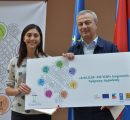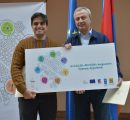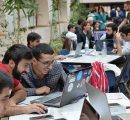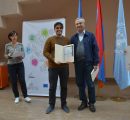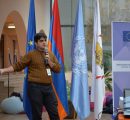
AUA Students and Faculty Win 2nd and 3rd Prize at Smart City Hackathon
2 min read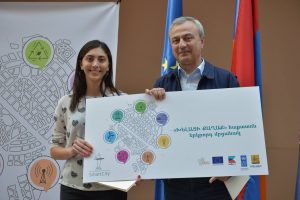 YEREVAN, Armenia – On October 14 and 15, American University of Armenia (AUA) students Gasia Atashian and Shahane Arushanyan, along with Adjunct Lecturer Arthur Dolmajian, participated in the Smart City Hackathon, organized by the Yerevan Municipality within the framework of Kola Lab’s Innovation for Development program, financed by the European Union and implemented by the United Nations Development Programme (UNDP). Atashian and Arushanyan were members of the Datathon team, which won 2nd prize (up to 4000 USD for idea implementation), while Dolmajian was part of the Smart Space team, which was awarded 3rd prize (up to 3000 USD for idea implementation).
YEREVAN, Armenia – On October 14 and 15, American University of Armenia (AUA) students Gasia Atashian and Shahane Arushanyan, along with Adjunct Lecturer Arthur Dolmajian, participated in the Smart City Hackathon, organized by the Yerevan Municipality within the framework of Kola Lab’s Innovation for Development program, financed by the European Union and implemented by the United Nations Development Programme (UNDP). Atashian and Arushanyan were members of the Datathon team, which won 2nd prize (up to 4000 USD for idea implementation), while Dolmajian was part of the Smart Space team, which was awarded 3rd prize (up to 3000 USD for idea implementation).
Participants split up into 16 teams working to solve a variety of different issues ranging from garbage collection and waste management, to using augmented reality for tourism, to developing tools for mapping and monitoring environmental pollution, to electronic management of residential buildings, and so on. Teams had only five minutes to present their results, and another five minutes for questions and answers.
The jury panel consisted of Arthur Petrosian, chair of AUA’s Computer Science department, Mikayel Vardanyan, chief technical officer at PicsArt, Eduard Musayelyan, head of the Union of Employers of Information and Communication Technologies, Pierre Hennes, partner at Granatus Ventures fund, and others.
The Datathon team presented their solution for smart garbage collection and trash bin allocation. The team used datasets provided by Sanitek to track garbage collection routes and assess the density of the population and number of trash bins installed in two districts of Yerevan. Based on this data, they developed a model to optimize waste management.
The Smart Space team developed a tool for monitoring quality of life in different districts of Yerevan. The idea was to create a visual tool that calculates a quality of life index for the city using the data provided by the municipality. The tool is meant as a diagnostic, planning, and simulation tool for city planners or researchers. The user can load data into it and set up a simple equation to calculate the index. It then visually shows the calculated quality of life index on the map using color intensity (light to dark) to indicate the quality of life in a given area. It also shows the uniformity, or lack thereof, across the city, visually pinpointing the areas that need improvement. The tool was based on analysis of data-sets on environmental pollution, mapping of residential buildings, data from mobile operators and other layers of information. The solution would support city management and businesses, providing metrics on a range of areas, such as which areas need further greening or greater access to public or private service provision units.
Dolmajian, who has participated in several other hackathons, believes the data being provided during these events is getting better and better in terms of relevance and quality. “The data culture in Armenia is growing in the right direction and having the municipality or other public governance bodies participating in providing data is a very positive step forward,” he said.
Founded in 1991, the American University of Armenia (AUA) is a private, independent university located in Yerevan, Armenia and affiliated with the University of California. AUA provides a global education in Armenia and the region, offering high-quality, graduate and undergraduate studies, encouraging civic engagement, and promoting public service and democratic values.


